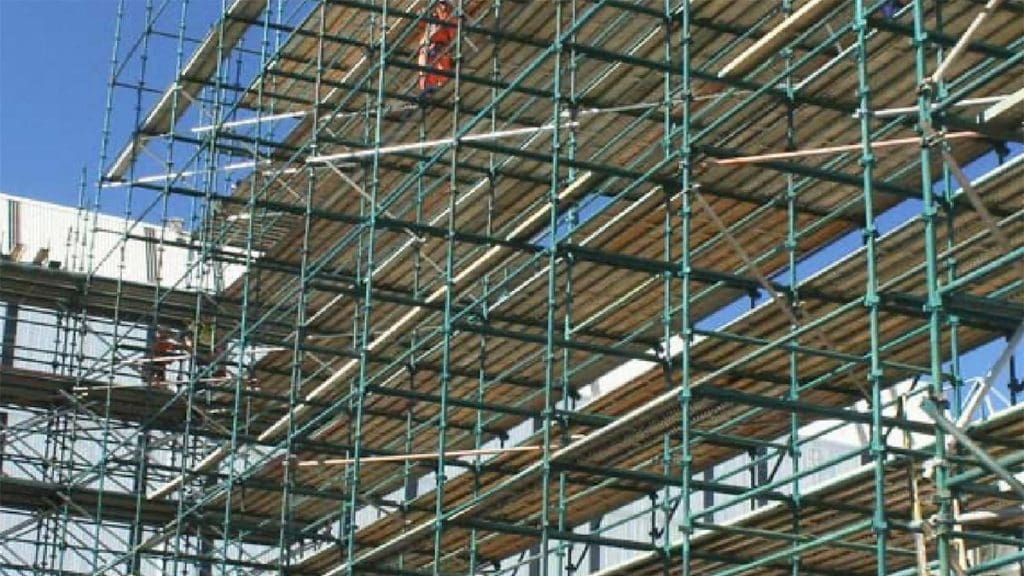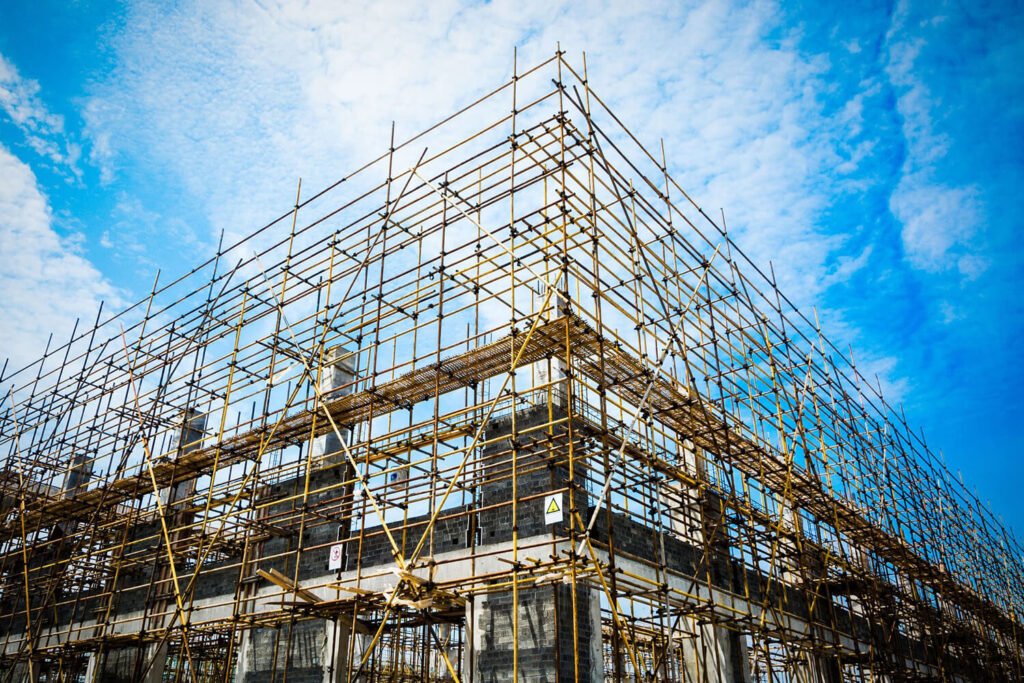Local Scaffolding Company Providing Reliable Services Throughout Surrey
Wiki Article
A Comprehensive Guide to the Essential Features of Scaffolding in Modern Construction
The landscape of modern-day construction progressively depends on efficient scaffolding systems that focus on efficiency, innovation, and safety. As tasks grow in complexity, understanding the important functions of scaffolding ends up being crucial for making certain employee safety and security and maximizing task timelines.Types of Scaffolding
Although scaffolding systems can vary widely in style and application, they normally fall into several distinctive groups that provide to different building and construction needs - Scaffolding. One of the most typical types include sustained scaffolding, suspended scaffolding, and rolling scaffoldingSupported scaffolding is composed of systems supported by a framework of posts, which supply a raised and steady working surface area. This type is commonly made use of for tasks that require substantial altitude, such as bricklaying or outside painting.
Put on hold scaffolding, on the other hand, is made use of for jobs needing accessibility to high altitudes, such as cleansing or fixing structure exteriors. This system hangs from one more structure or a rooftop, enabling employees to lower or increase the system as required.
Rolling scaffolding attributes wheels that permit simple mobility across a work site. It is specifically helpful for jobs that call for constant relocation, such as indoor operate in large areas.
Each kind of scaffolding is created with particular applications in mind, making certain that construction jobs can be accomplished efficiently and efficiently. Recognizing these categories is vital for picking the appropriate scaffolding system to fulfill both job demands and site problems.
Trick Security Features
Security is vital in scaffolding systems, as the possible threats connected with functioning at heights can result in severe crashes otherwise effectively taken care of. Key safety features are important to guarantee the wellness of workers and the integrity of the building site.Primarily, guardrails are important. These barriers give a physical guard against falls, considerably decreasing the risk of major injuries. Furthermore, toe boards are typically utilized to stop tools and materials from diminishing the scaffold, shielding employees below.
One more vital part is making use of non-slip surfaces on platforms. This attribute improves grip, particularly in adverse climate condition, therefore reducing the possibility of falls and slides. Accessibility ladders must be securely placed to assist in safe access and departure from the scaffold.
Normal assessments and maintenance of scaffolding systems are also essential. These assessments ensure that all parts are in good problem and functioning appropriately, resolving any wear or damage quickly.
Lastly, appropriate training for all employees associated with scaffolding procedures is important to make sure that they understand security methods and can identify prospective hazards. Scaffolding. Collectively, these attributes create a much safer working setting and considerably minimize risks connected with scaffolding
Product Innovations
Improvements in product scientific research have actually dramatically affected the scaffolding sector, boosting both safety and security and performance in modern-day building and construction. The intro of high-strength steel and light weight aluminum alloys has actually transformed conventional scaffolding systems.Furthermore, innovative composite materials, such as fiberglass-reinforced plastics, have actually become viable alternatives. These products are immune to rust and ecological destruction, hence prolonging the lifespan of scaffolding systems, particularly in harsh climate condition. Using such products adds to reduce maintenance expenses and makes sure regular efficiency in time.


Layout Factors To Consider
Thinking about the complexities of modern construction tasks, reliable scaffolding style is vital to guaranteeing both functionality and safety. Layout factors to consider should encompass numerous factors, including load capacity, elevation, and the particular requirements of the construction website. Each project provides one-of-a-kind difficulties, demanding an adaptable strategy to scaffolding systems that can adapt to differing problems.Architectural honesty is crucial; as a result, designers have to determine the lots that the scaffolding will certainly support, consisting of employees, products, and equipment. The selection of materials plays an essential duty in ensuring the scaffolding can stand up to these loads while continuing to be resilient and lightweight. Additionally, the layout must permit for easy gain access to and egress, helping with the smooth movement of workers and materials.
Safety attributes, such as guardrails and non-slip surfaces, must be incorporated to lessen threats of accidents. Moreover, the layout should consider the surrounding atmosphere, consisting of surrounding structures and prospective threats. By resolving these design considerations, building companies can boost the performance of scaffolding systems and advertise a more secure working atmosphere, inevitably adding to the overall success of the project.
Maintenance and Evaluations
The efficiency of scaffolding systems expands past initial design and execution; ongoing upkeep and normal examinations are essential to guaranteeing their proceeded performance and safety throughout the period of a job. Regular evaluations ought to be carried out by qualified personnel to identify any signs of wear, damages, or instability that might jeopardize the stability of the scaffolding.Maintenance protocols should consist of regular checks of structural parts, such as slabs, installations, and structures, making sure that all elements remain cost-free and safe and secure from rust or other damage. In addition, the performance of safety attributes, such as guardrails and toe boards, need to be evaluated to make sure compliance with safety laws.
Paperwork of all inspections and upkeep activities is crucial for accountability and regulatory conformity. A systematic strategy to record-keeping not just aids in tracking the problem of the scaffolding yet additionally offers essential evidence in case of an occurrence.
Ultimately, developing an extensive upkeep and evaluation timetable will substantially reduce the danger of crashes and enhance the general safety and security of the building and construction site. By prioritizing these techniques, construction supervisors can guard employees and support the job's honesty.

Conclusion
In conclusion, the vital functions of scaffolding in contemporary building encompass a variety of vital elements, including diverse types, key safety and security devices, product advancements, and thoughtful style considerations. Emphasizing safety through Scaffolder Surrey guardrails and non-slip surfaces, alongside advancements in products like high-strength steel, boosts both performance and sustainability. Routine maintenance and examinations are important for ensuring architectural honesty and security on construction websites, ultimately promoting effective job implementation and promoting the well-being of employees.The landscape of contemporary construction significantly depends on efficient scaffolding systems that prioritize security, innovation, and effectiveness.Improvements in material science have actually considerably affected the scaffolding industry, enhancing both security and effectiveness in modern-day building. Overall, these material innovations not only improve the efficiency and safety of scaffolding systems however also straighten with the sector's press in the direction of sustainability, as several modern products are made to be more environmentally friendly.
Thinking about the intricacies of modern-day construction projects, effective scaffolding style is vital to making certain both functionality and security.In conclusion, the necessary attributes of scaffolding in modern-day building and construction incorporate a range of crucial aspects, including diverse types, key security mechanisms, material innovations, and thoughtful design considerations.
Report this wiki page